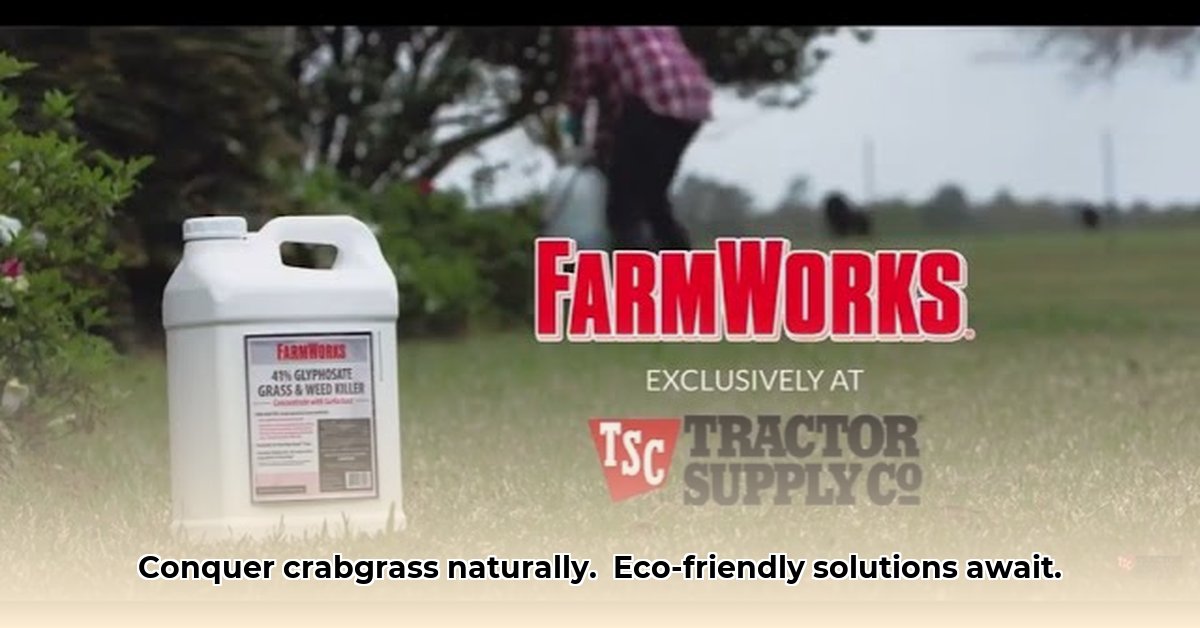
Dealing with crabgrass can feel like an uphill battle for farmers. This aggressive weed competes with crops for resources, impacting yields and profitability. But finding effective, environmentally friendly solutions is possible. For more natural solutions, consider exploring organic pest control options. This guide compares conventional and sustainable crabgrass control methods, helping you choose the best approach for your farm.
Understanding Crabgrass and its Impact
Crabgrass ( Digitaria spp.) is a fast-spreading annual weed that thrives in warm temperatures and disturbed soil. Its rapid growth quickly chokes out desirable crops, reducing yields and impacting harvest quality. This translates to direct financial losses, making effective control crucial for profitability. Beyond economics, uncontrolled crabgrass contributes to soil erosion and disrupts the natural ecosystem balance. How significant is this impact? Studies show that unchecked crabgrass can reduce crop yields by up to 50% in some cases.
Conventional vs. Sustainable Crabgrass Control Methods
Let's compare conventional and sustainable approaches to managing this tenacious weed.
Conventional Herbicides (e.g., Hypothetical "Ike's")
Conventional herbicides like the fictional "Ike's" offer rapid crabgrass elimination. They disrupt the weed's growth processes, providing immediate results. However, they have drawbacks:
- Environmental Impact: They can harm beneficial soil microorganisms, reducing soil fertility and impacting long-term soil health. Water contamination is also a risk if not applied carefully.
- Herbicide Resistance: Repeated use can lead to resistance in crabgrass populations, making them less effective over time.
- Regulatory Considerations: Strict regulations govern herbicide use; permits and careful application are required.
- Long-Term Costs: While initial costs might seem low, repeated application and potential crop loss due to soil damage increase long-term expenses.
Sustainable Alternatives (e.g., Hypothetical "BioAdvanced" and Non-Chemical Methods)
Sustainable options, like the fictional "BioAdvanced," and non-chemical methods offer a gentler approach with minimal environmental impact.
- BioAdvanced (Hypothetical): This product uses naturally derived ingredients to disrupt crabgrass growth without the harsh effects of synthetic chemicals. While possibly slower-acting than "Ike's," it poses less risk to beneficial organisms and water quality.
- Hand-weeding: Labor-intensive but effective for small areas, eliminating the need for chemicals entirely.
- Mulching: Deprives crabgrass of sunlight and moisture, inhibiting growth and improving soil moisture retention.
- Cover Cropping: Planting crops like rye or clover during fallow periods suppresses crabgrass establishment and improves soil health.
Choosing the Right Crabgrass Control Approach
Selecting the optimal method depends on several factors:
- Farm Size: Hand-weeding is suitable for small plots, while large-scale operations might necessitate herbicides.
- Crop Type: Herbicide choice depends on your main crop's sensitivity to different chemicals.
- Budget: Though sustainable options offer long-term cost savings, the initial investment might be higher.
- Environmental Priorities: Sustainable approaches align with environmentally conscious farming practices.
- Local Regulations: Compliance with pesticide regulations is essential.
The table below summarizes the pros and cons of each method:
| Method | Pros | Cons |
|---|---|---|
| Conventional Herbicides | Fast-acting, highly effective | Environmental impact, resistance development, regulatory complexities |
| Sustainable Alternatives | Environmentally friendly, improved soil health, long-term cost savings | Slower-acting, may require more labor |
| Hand-weeding | No chemicals, effective for small areas | Extremely labor-intensive |
| Mulching | Reduces weed growth, improves soil moisture | Initial cost of mulch |
| Cover Cropping | Prevents weed growth, improves soil health, diversifies your farm ecology | Requires planning and management |
Best Practices for Application
Effective application is key, regardless of the chosen method. Always follow label instructions carefully for herbicides. For sustainable methods:
- Timing: Apply pre-emergent herbicides before weeds germinate. For mulching and cover cropping, timing is crucial for optimal weed suppression.
- Techniques: Ensure even herbicide application. For mulching, use a thick enough layer to effectively block sunlight.
- Safety: Wear appropriate protective gear, including gloves and eye protection, when handling any chemical treatments.
Long-Term Strategies: Integrated Pest Management (IPM)
Integrated Pest Management (IPM) is a holistic approach that prioritizes prevention. This includes:
- Crop Rotation: Alternating crops disrupts weed life cycles.
- Soil Health Improvement: Healthy soil is less susceptible to weed invasion. Focusing on soil health is a long-term investment that reduces reliance on chemical interventions.
- Preventative Measures: Regular mowing, proper irrigation, and addressing soil compaction reduce weed establishment.
By implementing IPM, you can minimize your reliance on herbicides, promoting environmental health and long-term farm profitability. Remember, sustainable weed control requires consistent effort, but the resulting healthy harvest and environment make the investment worthwhile.